소아 학대와 소아 무관심(아동 학대와 아동 무관심/어린이 학대와어린이 무시 방치/아동 무시), Child abuse and child neglect-2, 안전사고로 인한 정신적 신체적 손상과 소아 학대 Psychological physical injury and child abuse, 스팽킹 체벌과 소아 학대 Spanking punishment and child abuse, 체벌과 소아 학대 Corporal punishment and child abuse
- “예방을 잘 하면 모든 사고는 생기지 않을 수 있다”고 생각하는 사람들은 안전사고 예방을 소홀히 해서 신체적 손상이 소아에게 생기거나 감정적 손상이 소아에게 생겨도 소아 학대를 한 것으로 따진다.
- 안전사고로 생긴 정신적 신체적 손상은 엄마아빠의 무관심으로 생긴 것이라고 인정되기 때문이다. 그러나 안전사고로 입은 정신적 신체적 손상은 소아 학대가 아니라고 주장하는 사람들도 있다.
스팽킹 체벌과 소아 학대
- 연구에 의하면, 75%의 소아청소년과 전문의들은 외상을 입힐 정도로 가한 스팽킹 체벌은 부적절한 스팽킹 체벌로 인정하지만 소아 신체 학대로 간주하지 않는다고 주장한다.
- 나머지 25%의 소아청소년과 전문의들은 엄마아빠가 자녀 양육상 스팽킹을 했지만 타박상을 입힐 정도로 스팽킹을 했으면 그런 유형의 스팽킹도 소아 신체 학대에 해당되고 아동 보호관계당국에 보고해야 한다고 주장했다.
체벌과 소아 학대
- 미 초중교와 가정에서 소아들에게 교육, 지도, 훈련, 양육을 목적으로 소아들에게 체벌을 주기도 한다.
- 체벌은 동서고금 자녀훈련을 시키는 통상적인 방법의 하나로 알려졌다. 연구에 의하면, 미국 초중교사들의 60%가 연간 적어도 한번 정도 학생에게 체벌을 주고,
- 미국 1,146쌍의 엄마아빠들의
- 73%가 3~17세 연령층에 있는 유아들, 학령기 아이들과 사춘기 아이들을 양육, 훈련 목적으로 육체적 정신적 폭력을 가했고,
- 58%는 스팽킹 체벌을 주고,
- 13%는 물건으로 때렸고,
- 5%는 물건을 던졌고,
- 3%는 발로 차고 물고 주먹으로 때렸고,
- 1%는 과거 1년 동안 자녀를 적어도 한번 정도 매로 때린 적이 있다고 설문조사에 응답했다.
- 많은 미국 사람들은 자녀 양육, 훈련을 할 때 적절한 체벌을 가해도 괜찮다고 믿고 있다.
- 미 소아청소년과 학회는 자녀 양육, 훈련을 하기 위해 1세 이후 유아나 학령기 아이의 손이나 엉덩이를 엄마아빠가 활짝 핀 손바닥으로 한두 번 정도 찰싹 치는 체벌은 자녀 양육 훈련에 필요한 스팽킹 체벌이고 소아 신체 학대에 속하지 않는다고 믿고 있다.
- 소아 자녀의 비행을 바로 잡기 위해 엄마 아빠가 활짝 핀 손바닥 이외 어떤 종류의 기구를 이용해 소아 자녀의 신체의 어느 부위를 때리는 것은 소아 신체 학대에 속한다고 정의한다.
- 소아 자녀에게 체벌을 줄 때 자녀의 얼굴이나 머리를 때리는 것은 자녀 양육, 훈련을 위한 체벌로 간주하지 않고 소아 신체 학대에 해당된다고 정의한다.
- 소아 자녀를 돌보는 베이비시터나 보호자가 어떤 이유로든 소아의 잘 못한 행동을 바로 잡기 위해 소아에게 체벌을 주어 신체적 손상을 입혔을 때,
- 소아의 손이나 엉덩이 이외 신체 다른 부위를 손바닥이나 다른 것으로 때렸을 때,
- 활짝 핀 손바닥으로 체벌을 받은 엉덩이나 손에 홍색 피부 반점이나 적색 피부 반점이 나 타나는 이외 어떤 신체적 손상이 생기면 소아 신체 학대로 취급된다.
- 생후 12개월 이전 영아들에게 어떤 방법으로든 체벌을 가하면 소아 신체 학대에 해당된다.
- 손바닥이 아닌 어떤 종류의 기구로 신체의 어느 부위든지 체벌을 주는 것도 소아 신체 학대에 해당된다.
- 밀거나, 접촉시키거나, 충돌시키거나,
- 자상을 입히거나,
- 열이나 부식성 화학물질에 접촉시키거나,
- 불필요한 약물을 먹이는 행동도 소아 신체 학대에 해당된다.
소아 신체 학대의 증상 징후
- 소아 신체 학대를 한 엄마아빠나 보호자가 자발적으로 소아 신체 학대를 했던 사실을 인정하면서 병원 응급실이나 소아청소년과로 소아 자녀를 데리고 오는 경우도 가끔 있다.
- 대부분의 경우, 소아 신체 학대로 생긴 부상 때문에 소아들을 병원에 데리고 왔을 때, 그 부상의 원인, 정도, 입은 때, 상처 받은 경로, 방법과 장소 등에 관한 병력에 모순성이 많이 있고 사실성과 거리가 멀고 병력에 일률성이 없는 때가 많다.
- 소아들에게 상처가 있을 때, 상처가 생기게 된 이유를 확실히 설명할 수 없는 때는 그 상처가 소아 신체 학대로 인해 생겼나 의심해 보는 것이 보통이다.
- 소아 신체 학대로 생긴 상처의 대부분은 소아청소년의 나이와 성장 발육에 일치되지 않을 때가 많다.
- 소아 신체 학대로 상처가 생겼을 때는 상처를 입은 후 치료를 곧 받지 않고 늦게 치료받는 경향이 있다.
- 소아 신체 학대를 받고 자란 소아들에게 공격적 성격, 대인관계 문제, 우울증, 애정문제, 약물남용, 알코올 중독 등 행동 정서 감정 대인 관계에 문제가 잘 생긴다.
- 체중 및, 또는 신장이 5 퍼센타일이거나 그 이하일 때가 더 많다.
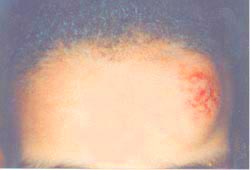
사진 433. 소아 학대로 생긴 두피좌상
Copyright ⓒ 2011 John Sangwon Lee, MD., FAAP
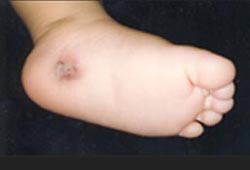
사진 434. 담뱃불로 지져 생긴 열화상도 소아 신체 학대에 속한다.
Copyright ⓒ 2011 John Sangwon Lee, MD., FAAP
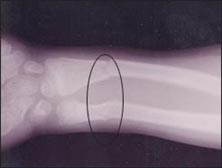
사진 435. 소아 신체 학대로 생긴 척골 골절과 요골의 골절.
Copyright ⓒ 2011 John Sangwon Lee, MD., FAAP
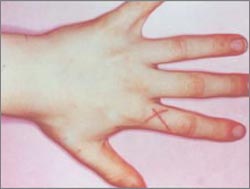
사진 436. 소아 신체 학대로 생긴 절상.
Copyright ⓒ 2011 John Sangwon Lee, MD., FAAP

사진 437. 소아 학대를 진단하기 위해 하지와 상지 등 전신의 뼈(골) X-선 사진 검사를 할 때도 있다
Copyright ⓒ 2011 John Sangwon Lee, MD., FAAP
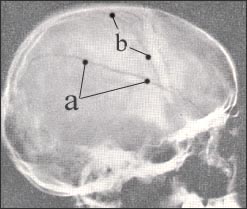
사진 438. 소아 신체 학대로 생긴 심한 두개골 골절
a-두골 골절, b-두골 봉합선
참고문헌: textbook of surgery, Christopher, 3rd ed.
다음과 같은 증상 징후가 있을 때 소아 신체 학대나 소아 무관심 학대를 의심할 수 있다.
- 위아래 입술의 소대의 외상,
- 확실히 이유를 밝힐 수 없는 치아 외상이나 입안의 외상,
- 양쪽 눈언저리에 생긴 멍, 눈의 망막 출혈 등
- 피부 멍, 특히 멍든 피부색이 여러 종류일 때, 대퇴부나 복부,
- 위팔의 연조직에 생긴 부상이나 화상,
- 사람에게 물린 이빨자국,
- 타박상, 매질 자국, 열상, 상흔, 혈종, 출혈 반점, 외상성 두피 탈모증, 손톱자국이나 손자국, 질식 시도로 목에 생긴 자국 등
- 담즙이 섞인 구토 물, 재발성 구토, 재발성 설사, 만성 복통, 복강 내 장기파열, 구토나 설사 등을 한다고 엄마가 호소하지만 엄마 이외 사람은 그 아이가 구토나 설사를 하는 것을 목격할 수 없을 때
- 두개골 골절, 경막하 출혈, 두개 강 내 뇌압 상승, 혼수, 경련, 무호흡 등
- 골막 하 출혈, 각종 골절 등
- 만성 회음부 통증, 외음부 통증, 항문 통증, 외음부 부상, 항문 부상 등
Child abuse and child neglect -2, Psychological physical injury and child abuse, spanking corporal punishment, Corporal punishment and child abuse
• People who think that “all accidents can’t happen with good prevention” are judged as having abused children even if they neglected to prevent safety accidents and caused physical damage to children or emotional damage to children.
• This is because it is recognized that the mental and physical damage caused by safety accidents is caused by the indifference of mothers and fathers. However, there are those who argue that the mental and physical damage caused by safety accidents is not child abuse.
Spanking Corporal Punishment and Child Abuse
• Studies show that 75% of pediatricians claim that traumatic spanking is considered inappropriate spanking, but not as physical abuse of the child.
• The remaining 25% of pediatric specialists argued that if mothers and fathers spanked for child rearing purposes but spanked enough to bruise, that type of spanking would also constitute child abuse and should be reported to the child protection authorities. Corporal
Punishment and Child Abuse
• In the US elementary and middle schools and at home, corporal punishment is used for the purpose of educating, guiding, training, and raising children.
• Corporal punishment has been known as one of the common methods of training children in all ages. According to a study, 60% of elementary and middle school teachers in the U.S. inflict corporal punishment on students at least once a year.
• 1,146 pairs of mothers and fathers in the United States
o 73% were physically or mentally abused for the purpose of raising or training children between the ages of 3 and 17, school-age children and adolescents;
o 58% give spanking corporal punishment,
o 13% hit with objects, o 5% threw objects,
o 3% were kicked, bitten and punched,
o 1% responded to the survey that they had beaten their child with a rod at least once in the past year.
o Many Americans believe that appropriate corporal punishment is okay for child rearing and training.
o According to the American Academy of Pediatrics, corporal punishment in which mothers and fathers rub the hands or buttocks of infants or school-age children after one year of age once or twice with their open palms once or twice for child rearing and training are spanking corporal punishment necessary for child rearing training. I believe that I do not belong to abuse.
o It is defined as physical abuse of a child when a mother or father strikes any part of the child’s body with an instrument of any kind other than an open palm to correct the child’s misbehavior.
o When inflicting corporal punishment on a child, it is defined that hitting a child in the face or head is not considered corporal punishment for child rearing or training, but constitutes child physical abuse.
o When, for any reason, the babysitter or caregiver caring for the child inflicts bodily harm on the child by corporal punishment to correct the child’s misbehavior;
• When a child’s hand or other part of the body other than the hip is hit with a palm or other object;
• Any physical damage other than red or red patches of skin on the buttocks or hands that has been corporal punishment with an open palm is treated as physical abuse of a child.
• Any form of corporal punishment on infants before 12 months of age constitutes child physical abuse.
• Physical punishment of any part of the body with any device other than the palm of the hand constitutes physical abuse of a child.
• Push, touch, collide,
• Injure yourself; • contact with heat or corrosive chemicals;
• The act of giving unnecessary drugs also constitutes child physical abuse.
Symptoms, signs of Child Physical Abuse
• Sometimes mothers, fathers, or guardians who have been physically abused children bring their children to the hospital emergency room or pediatric department, admitting that they voluntarily abused children.
• In most cases, when children are brought to the hospital for injuries resulting from physical abuse of children, there are many contradictions and inconsistencies in the medical history regarding the cause, severity, time of injury, route, method, and location of the injury. It is far away and there are many times when there is no uniformity in the troops.
• When children have wounds, when it is not possible to clearly explain the cause, it is common to suspect that the wound was caused by physical abuse of the child.
• Most of the wounds caused by physical abuse of children do not match the age and development of children and adolescents.
• When wounds are caused by physical abuse of children, they tend to be treated late rather than soon after the injury.
• Children who grow up after being physically abused often have behavioral, emotional, emotional, and interpersonal problems such as aggressive personality, interpersonal problems, depression, love problems, substance abuse, and alcoholism.
• Weight and/or height are more often at or below the 5th percentile.

Photo 433. Scalp strain caused by child abuse Copyright ⓒ 2011 John Sangwon Lee, MD., FAAP

Photo 434. Thermal burns caused by burning a cigarette also belong to child physical abuse. Copyright ⓒ 2011 John Sangwon Lee, MD., FAAP

Photo 435. Fractures of the ulna and radius due to physical abuse of children. Copyright ⓒ 2011 John Sangwon Lee, MD., FAAP

Picture 436. Injuries resulting from child physical abuse. Copyright ⓒ 2011 John Sangwon Lee, MD., FAAP

Picture 437. X-ray examination of bones (bone) of the whole body, such as lower extremities and upper extremities, is sometimes done to diagnose child abuse Copyright ⓒ 2011 John Sangwon Lee, MD., FAAP

Picture 438. Severe skull fracture caused by child physical abuse a – skull fracture, b – skull suture References: textbook of surgery, Christopher, 3rd ed.
Child physical abuse or child neglect abuse may be suspected when the following symptoms are present:
1. Trauma of the platoon of the upper and lower lips,
2. Tooth trauma or oral trauma for unknown reasons;
3. Bruising around both eyes, retinal hemorrhage, etc.
4. Skin bruises, especially when the bruises are of different colors, on the thighs or abdomen,
5. Injuries or burns to the soft tissue of the upper arm;
6. Tooth marks from human bites;
7. Bruises, beating marks, lacerations, scars, hematomas, bleeding spots, traumatic scalp alopecia, nail marks or handprints, marks on the neck from attempts to asphyxiation, etc.
8. The mother complains of vomit mixed with bile, recurrent vomiting, recurrent diarrhea, chronic abdominal pain, rupture of the abdominal cavity, vomiting or diarrhea, but no one other than the mother can witness the child vomiting or diarrhea. when not
9. Skull fracture, subdural hemorrhage, increased intracranial pressure, coma, convulsions, apnea, etc.
10. Subperiosteal hemorrhage, various fractures, etc.
11. Chronic perineal pain, vulvar pain, anal pain, vulvar injury, anal injury, etc.
출처 및 참조 문헌 Sources and references
- NelsonTextbook of Pediatrics 22ND Ed
- The Harriet Lane Handbook 22ND Ed
- Growth and development of the children
- Red Book 32nd Ed 2021-2024
- Neonatal Resuscitation, American Academy of Pediatrics
- B형 간염 Hepatitis B
- B형 간염 예방접종 Hepatitis B immunization
- B형 간염 예방접종을 꼭 받아야 하는 사람들 Persons who should have hepatitis B immunization
- 피나 피로 만든 약을 쓸 때 B형 간염에 대한 유의할 사항 Hepatitis B Precaution for using blood or product medicine Precaution for hepatitis B vaccination
- B형 간염을 한 번도 앓은 적이 없는 사람들에게 B형 간염 예방접종을 해 주는 방법 How to give hepatitis B vaccine C형 간염/HCV 간염 Hepatitis C
- D형 간염 Hepatitis D
- E형 간염 Hepatitis E
- G형 간염 Hepatitis G
- The Johns Hopkins Hospital, The Harriet Lane Handbook, 22nd edition
- Red book 31st edition 2021
- Nelson Text Book of Pediatrics 21st Edition
- Infectious disease of children, Saul Krugman, Samuel L Katz, Ann A. Gershon, Catherine Wilfert
- Emergency Care Transportation of Sick and Injured American Academy of Orthopaedic Surgeons
- Emergency Pediatrics A Guide to Ambulatory Care, Roger M. Barkin, Peter Rosen
- Gray’s Anatomy
- Ambulatory Pediatrics, Green and Haggerty, Saunders
- Introduction to Clinical Pediatrics, Smith and Marshall, W.B. Saunders Co
- School Health: A Guide For Health Professionals, American Academy of Pediatrics
- Holly Bible
- How to really love your child Ross Campbell
- Good Behavior Stephen W. Garber, Ph.D. and other
- Kids Who follow, Kids who don’t
- Loving Each Other Leo F Buscaglia, Ph, D.
- Guide to Your Child’s Sleep. American Academy of Pediatrics
- Hematology and Oncology in Adolescence, Neil J. Grossman, M.D., Stuart S. Winter, M.D., Adolescent Medicine, and The Media Adolescents Medicine
- AM: Stars Adolescent Medicine: State of the Art Reviews, Asthma, and Diabetes in Adolescents, Robert A. Wood, M.D., Samuel J. Casella, M.D. April 2010, AAP
- AM: Stars Adolescent Medicine: State of the Art Reviews, Sleep and Sleep Disorders in Adolescents, Amy E. Sass, M.D., MPH, David W. Kaplan, M.D., MPH Editors December 2010, AAP
- The Pediatric Clinics of North America, Adolescent Gynecology, Part II THe Sexually Active Adolescent, August 1999
- The Pediatric Clinics of North America, Childhood and Adolescent Obesity, August 2001
- Adolescent Dermatology, Daniel P. Krowchuk, M.D., Anne W. Lucky, M.D., Adolescent Medicine, 12:2 June 2001
- Gastrointestinal Disorders, Jeffrey S. Hyams. M.D. Editor, Adolescent Medicine
- Fueling the Teen Machine, Ellen Shanley and Colleen Thompson
- Why Teenagers Act the Way They Do, Eight Adolescent Personality Types: Understanding and Dealing With Them, Dr. G. Keith Olson
- Adolescent Psychiatry, Adolescent Medicine Clinics, Feb. 2006 Vol 17 #1 Richard E. Kreipe, M.D., Christopher H. Hodgman, M.D.
- Adolescent and the Media, Adolescent Medicine Clinics June 2005 Vol 16 #3, Guest Editors: Victor C. Strasburger, Marjorie J. Hogan, M.D.
- 진정한 자녀 사랑 나비게이터
- 10대 아들 딸 이렇게 사랑해 키워라 이상원 역저 (How to really love your teenager. Ross Campbell MD)
- 소아과학 대한교과서
- 의학 용어사전 대한 의사 협회
- 그 외